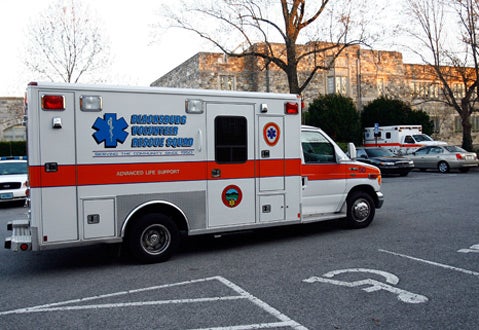As if sex education and stern lectures about drug abuse and bullying weren’t already enough, America’s teenage students are now being educated in how to survive another prominent hazard of modern campus life: high-school shootings.
Hundreds of American colleges and universities have purchased a video training programme that teaches staff and pupils what to do in the event that a lone gunman should decide to walk into their classroom and open fire.
The twenty minute video, entitled ‘Shots Fired on Campus’, explains how victims can take advantage of their strength in numbers, and fight back with improvised weapons such as laptops and computer bags. It is currently being shown to students returning from their summer vacation at 500 colleges in the USA and Canada.
It has the tone of a slightly macabre corporate training video at times, but the dramatic reconstruction of a suicidal teenager opening fire in a packed classroom brings home the film’s seri
ous message: it was made in the aftermath of the recent Virginia Tech and Northern Illinois shootings, in which dozens of teachers and pupils were killed.
Security chiefs at some of America's biggest campuses now say that although high-school shootings are still very rare, they have a duty to prepare staff and students for the possibility that they might occur.
“I parallel this with fire drills,” said Tim Walters, Chief of Police at Eastern Washington University, where all 10,000 students are required to watch the film. “Fires are very rare, but we still do fire drills all the time. Why shouldn’t we train our kids about what they can do to survive an active shooter situation?”
“We are a very safety conscious university. Now in any shooting, the students are the first ones in the firing line, however quickly law enforcement arrives. So by showing students this video, we are giving them a visual idea about what might happen, and how to react when it does.”
The training programme was created by Randy Spivey, a former US Department of Defence hostage negotiator who now runs a private security firm. The video aims to school students in a “survival mindset,” teaching them how to recognise gunfire, and advising them to follow a three-step programme in the event that they hear it on campus: “get out,” “hide out,” or “take out.” In the third scenario, where victims are unable to either leave the classroom or hide, Spivey advises them to use their numerical superiority to disable an attacker.
“If you look at Virginia Tech, most of the shootings took place in a second floor classroom with windows. The shooter came in, shot a couple of people, and then left. He came back later and killed more of them. If they had been thinking about their options properly, they might very well have decided to climb out of the window,” he said.
“The difference between trained and untrained people in a crisis situation is that untrained ones will panic, and maybe huddle together for support. But if they were acting logically they might realise that if you have one gunman in a room full of 200 people, the odds are very much in the favour of the 200 people.”
Although the training programme costs a hefty $1450, Spivey denied that he was profiteering from paranoia. “There are two extremes. On the one hand is paranoia, and on the other is oblivion,” he said. “We’re just trying to get people to keep this on their radar, and to sport the warning signs, or red flags, that mean a student is about to commit an act of violence. Some schools say it has changed their entire culture.”
Some experts disagree. Loren Coleman, a retired professor from the University of Southern Maine, and one of America’s foremost experts on teenage suicide and high school shootings, said the programme, which Spivey expects to be in 1,000 campuses by the end of the year, could inspire troubled students to commit acts of violence.
“It’s a terrible, terrible idea, something that everybody within the violence prevention profession should recoil against. If you put a video programme like this out there, it becomes just another thing for young people to copy. It will produce what people call behaviour contagion, become a training manual for violence.”
“It’s a graphic demonstration of fear marketing, and it gives away all the counter measures, of law enforcement, psychologists, and negotiators can use," he added. "For $1500, schools would be far better off getting a counsellor over once a week to speak with vulnerable students and prevent this kind of thing happening in the first place.”
Subscribe to Independent Premium to bookmark this article
Want to bookmark your favourite articles and stories to read or reference later? Start your Independent Premium subscription today.


Join our commenting forum
Join thought-provoking conversations, follow other Independent readers and see their replies